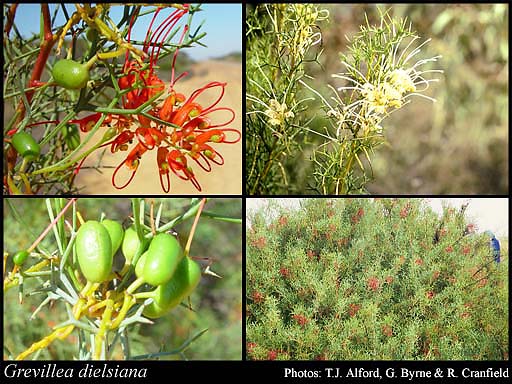- Reference
- J.Roy.Soc.Western Australia 27:169 (1942)
- Conservation Code
- Not threatened
- Naturalised Status
- Native to Western Australia
- Name Status
- Current
Spreading, non-lignotuberous shrub, (0.3-)0.6-2(-2.5) m high. Fl. red/red-orange/yellow-orange/pink, Apr to Oct. Yellow sand. Sandplains.

Scientific Description
Shrubs, 1.5-2 m high; branchlets glabrous or hairy, with a glaucous bloom. Leaves alternate, 30-80 mm long, hairy, on the abaxial surface, the hairs straight; lamina flat, twice or more divided, tripartitely divided, divided to the midrib; lobes 8-20 mm long, 1 mm wide, the margins revolute, enclosing the lower surface of the leaf blade, forming a groove either side of the midvein. Inflorescences terminal, yellow, orange or red; pedicels 4-7 mm long. Perianth 7-10 mm long; tepals all free after flower opens, glabrous; ovary glabrous, stipitate, the stipe 2-3 mm long; pistil 25-35 mm long, red, pollen presenter lateral, style glabrous. Follicles glabrous, not viscid, dehiscent, 10-14 mm long. Flowers in August or September. Occurs in the Eremaean (ER) or South-west (SW) Botanical Province(s), in the Yalgoo (YAL), Geraldton Sandplains (GS) or Avon Wheatbelt (AW) IBRA subregion(s).
Distribution
- IBRA Regions
- Avon Wheatbelt, Geraldton Sandplains, Yalgoo.
- IBRA Subregions
- Edel, Geraldton Hills, Lesueur Sandplain, Merredin.
- Local Government Areas (LGAs)
- Chapman Valley, Greater Geraldton, Irwin, Mingenew, Morawa, Northampton, Perenjori, Shark Bay, Three Springs.